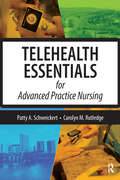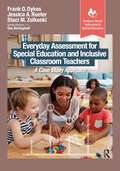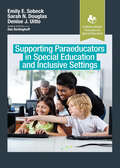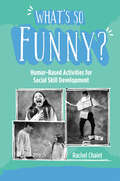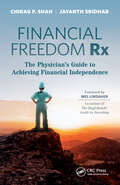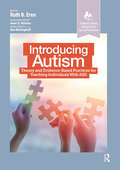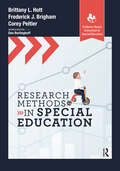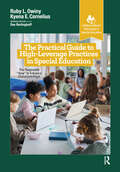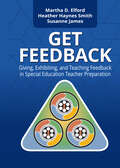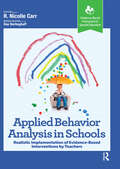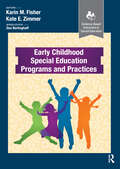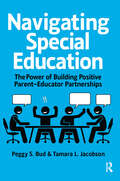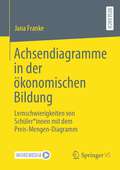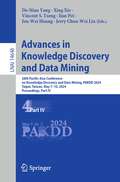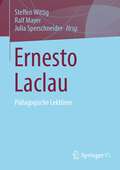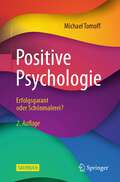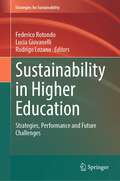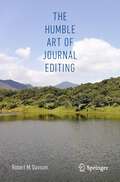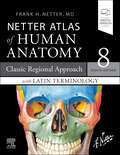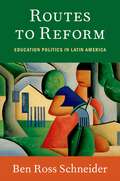- Table View
- List View
Telehealth Essentials for Advanced Practice Nursing
by Patricia Schweickert Carolyn RutledgeA timely, practical, and concise resource for advanced practice registered nursing (APRN) students, faculty, and providers, Telehealth Essentials for Advanced Practice Nursing provides readers with an understanding of and tools to embrace the emerging field of telehealth and optimize its application in clinical practice. Telehealth offers a unique solution to many health-care challenges, such as provider shortages, chronic disease management, an aging population, protection from infectious disease, and limited access to care. As telehealth is being incorporated into health care and health care delivery at an ever-increasing rate, APRNs that can navigate the telehealth arena are uniquely positioned to serve as leaders in the health care of the future. Using Telehealth Essentials for Advanced Practice Nursing, readers will learn how to utilize telehealth to provide new and innovative methods of care.Authors Patty A. Schweickert and Carolyn M. Rutledge present a multi-modal approach to telehealth education that layers telehealth onto nurses’ existing knowledge of nursing practice. The text begins with the history and basics of telehealth before moving on to critical content that a provider must understand to maximize its use in the health care arena, covering topics including: Technology used in the early response to infectious diseases such as COVID-19 The process of integrating telehealth in practice Laws, policies, and regulations governing telehealth practice Barriers to implementation and strategies for overcoming them Telehealth etiquette and ethics Using telehealth for effective interprofessional collaboration Each chapter includes group exercises, prompts for reflection, questions for discussion, and case studies. Included with the text are online supplemental materials for faculty use in the classroom.With Telehealth Essentials for Advanced Practice Nursing, APRN students, faculty, and practicing providers will learn to advocate for telehealth implementation, establish telehealth programs, and utilize telehealth to overcome barriers to care in order to optimize access and quality of care.
Everyday Assessment for Special Education and Inclusive Classroom Teachers: A Case Study Approach (Evidence-Based Instruction in Special Education)
by Frank Dykes Jessica Rueter Staci ZolkoskiEveryday Assessment for Special Education and Inclusive Classroom Teachers: A Case Study Approach provides a foundation in practical research-based methods to help today’s teachers tailor their instruction to meet the needs of all learners.With an easy-to-understand format, Everyday Assessment for Special Education and Inclusive Classroom Teachers combines real-life case studies with practitioner-friendly wording to teach and describe assessment topics in a concise manner. Practical applications for use in classroom settings can also be found throughout the text.What’s included in Everyday Assessment for Special Education and Inclusive Classroom Teachers: Example progress monitoring charts Curriculum-based assessments, behavior charts, and norm-referenced assessments to guide the reader when extracting data and inform everyday teaching practices Activities to practice skills and self-reflect on learning objectives at the end of each chapter Everyday Assessment for Special Education and Inclusive Classroom Teachers: A Case Study Approach pairs rationale and research with real-life case studies and applications for practice to prepare pre-service teachers to meet the unique needs of every learner.
Supporting Paraeducators in Special Education and Inclusive Settings (Evidence-Based Instruction in Special Education)
by Sarah Douglas Emily Sobeck Denise UittoSupporting Paraeducators in Special Education and Inclusive Settings provides an in-depth look at the role of pre- and in-service teachers as supervisors of paraeducators within special education and inclusive settings.The latest entry within the Evidence-Based Instruction in Special Education series, Supporting Paraeducators in Special Education and Inclusive Settings serves as an instructional tool for pre-service teachers and educators within higher education coursework, as well as a resource for in-service teachers. This text supports teachers in strengthening their knowledge and supervisory skills necessary to supervise and manage paraeducators in educational environments.Through objectives, scenarios, content, and chapter questions, Drs. Sobeck, Douglas, and Uitto provide a thorough and applicable overview of working with and supervising paraeducators. In this text the roles and responsibilities of paraeducators, teachers, and school administrators relative to paraeducator training and supervision will be detailed, as well as tips for collaboration.Included with the text are online supplemental materials for faculty use. School leaders and higher education faculty can use the online site for materials to support pre-service training within teacher preparation programs and professional development for in-service teachers.Supporting Paraeducators in Special Education and Inclusive Settings fills an important need in the field and is a vital resource for current and future teachers when working with paraeducators.
What's So Funny?: Humor-Based Activities for Social Skill Development
by Rachel ChaietWith ready-to-use lessons and strategies, What’s So Funny?: Humor-Based Activities for Social Skill Development provides readers with tools to help their clients improve their emotional intelligence through humor. Occupational therapists, speech-language pathologists, special educators, behavior therapists, and caregivers will benefit from the implementation of these strategies.What’s So Funny? contains a curriculum of more than 50 activities that emphasize two main ideas. The first is that humor (linguistic or physical) can be taught to many individuals with autism spectrum disorder or other disorders through explicit instruction, exposure to various types of humor, and embracing the individual’s preferred sense of humor. The second is that humorous activities can be used to increase social engagement, which can sometimes be a challenge for those with developmental disabilities.What’s So Funny? includes activities essential for individuals who: Appear to have a very limited concept or basic developmental level of humor Need to improve their understanding of socially appropriate humor Lack understanding of appropriate times to use humor Are nonverbal, have limited expressive communication skills, or use augmentative communication devices Have a difficult time initiating social interactions with their peers With a flexible program that can be used for either small groups or individuals from ages 7 years to adult, What’s So Funny?: Humor-Based Activities for Social Skill Development is a relevant and easy-to-use resource. Discussing a variety of types of humor on different developmental levels, from slapstick to word play, this program improves participants’ abilities to connect and engage with others through the powerful tool of humor.
Financial Freedom Rx: The Physician’s Guide to Achieving Financial Independence
by Chirag Shah Jayanth Sridhar"The best physician-specific general financial book published in 2021." —James M. Dahle, MD, author of The White Coat InvestorA step-by-step guidebook for doctors and other medical professionals about growing and preserving wealth, Financial Freedom Rx: The Physician’s Guide to Achieving Financial Independence gives physicians all the tools necessary to manage their own finances and includes a foreword by Mel Lindauer, co-author of The Bogleheads' Guide to Investing. Medical professionals, especially doctors, spend many years in training as they accumulate debt and delay their earnings. This book presents a time-tested formula that students and established professionals can follow at any stage during their careers to achieve fiscal peace of mind. Students will learn how to budget and adopt disciplined financial practices. Residents and other trainees will learn how to defend against calamity with various insurances and how to manage debt. Junior professionals will acquire the skills needed to invest and grow their portfolios, while senior professionals will better understand the essentials of estate planning and retirement. Drs. Chirag P. Shah and Jayanth Sridhar wrote this inspiring text to guide physicians where to put their next dollar. This is particularly important during the financial uncertainties brought on by COVID-19 and insurance cuts. Financial Freedom Rx sets forth principles that will pilot medical professionals toward financial independence. Chapters include useful advice on topics such as: Financial planning Investing and asset allocation Jobs and contracts Taxes and insurance Student loans and debt Retirement savings and distributions Financial Freedom Rx: The Physician’s Guide to Achieving Financial Independence serves as a timeless blueprint for financial planning that medical professionals will follow throughout their careers, and as a reference that readers will revisit again and again as they progress through the various stages of life.
Introducing Autism: Theory and Evidence-Based Practices for Teaching Individuals with ASD (Evidence-Based Instruction in Special Education)
by Ruth ErenWritten by educators for educators, Introducing Autism: Theory and Evidence-Based Practices for Teaching Individuals With ASD is an introductory text offering a broad picture of Autism Spectrum Disorder for students, teachers, related service providers, and other school personnel who are engaged in the education of individuals with ASD.Introducing Autism imparts knowledge and understanding of the broad spectrum of ASD and suggests evidence-based practices to support this population. Editor Dr. Ruth Eren and the text contributors provide readers with a firm foundation of facts, strategies, and processes that help explain and address the complex profile of an individual with ASD. As a result of this understanding, current and future practitioners will be equipped with the skills and strategies to work collaboratively and effectively with their school team as they create a program for a student on the spectrum.What’s included in Introducing Autism: Content supported by case studies based in authentic educational settings Evidence-based practices suggested for use in the classroom Voices from the Spectrum sections in each chapter which feature the viewpoints from individuals on the spectrum Introducing Autism: Theory and Evidence-Based Practices for Teaching Individuals With ASD will enable universities to offer a comprehensive course that provides a strong foundation of knowledge and understanding of ASD to prepare teachers and related service providers for certification.
Research Methods in Special Education (Evidence-Based Instruction in Special Education)
by Brittany Hott Frederick Brigham Corey PeltierResearch Methods in Special Education equips readers with the knowledge needed to make a difference with data. Authors Drs. Brittany L. Hott, Frederick J. Brigham, and Corey Peltier provide access to cutting edge methodologies and related skills researchers need to successfully carry out projects in applied settings. Dedicated chapters focusing on quantitative research synthesis (e.g., meta-analysis, meta-synthesis), single case design, and program evaluation methods allow readers deeply invested in the field of special education to develop a firm foundation, enabling them to ask and answer their socially significant research questions.Written for students in special education teacher prep programs, early career faculty, school administrators, and curriculum specialists, this text includes numerous features that set it apart from other available resources: Dedicated chapters on ethics, establishing effective research partnerships, and evidence-based practice Cutting-edge program evaluation methods and reporting Comprehensive coverage of methods commonly used in special education Detailed information on securing special education funding Case studies, exemplars, resources, and recommendations for additional reading Included with the text are online supplemental materials for faculty use in the classroom. YouTube videos featuring interviews with authors The up-to-date research practices in this text are a valuable addition for educators and researchers serving students with disabilities who have a responsibility to support in-school and post-school outcomes. Research Methods in Special Education gives educators the tools to facilitate a deeper understanding of the research process and evidence-based practice.
The Practical Guide to High-Leverage Practices in Special Education: The Purposeful “How” to Enhance Classroom Rigor (Evidence-Based Instruction in Special Education)
by Ruby L. Owiny Kyena CorneliusDesigned for teacher preparation programs as well as teacher professional development, The Practical Guide to High-Leverage Practices in Special Education: The Purposeful “How” to Enhance Classroom Rigor is the first book of its kind to introduce multiple HLPs working in tandem to implement evidence-based practices (EBPs).The Practical Guide to High-Leverage Practices in Special Education is a powerful tool for those dedicated to improving student outcomes. Planned with the practitioner in mind, the text’s main objective is for teachers to recognize EBPs as “what” they teach and HLPs as “how” they teach. The book is written with a focus on inclusive education, making it a valuable resource for both general and special educators.What’s included in The Practical Guide to High-Leverage Practices in Special Education: A focus on one HLP per chapter and descriptions of connected HLPs and how to use them for implementing featured EBPs Classroom scenarios for both elementary and secondary classrooms Tables of the crosswalks of connected HLPs and EBPs with resources forfurther learning The Practical Guide to High-Leverage Practices in Special Education: The Purposeful “How” to Enhance Classroom Rigor provides educators with the understanding of how HLPs and EBPs connect to effectively implement them for student success and is also an effective teaching and learning tool for teacher education preparation programs.
GET Feedback: Giving, Exhibiting, and Teaching Feedback in Special Education Teacher Preparation
by Susanne James Heather Smith Martha Elford“A powerful and rich resource of great ideas that will move the debates about feedback into the most worthwhile areas."—John Hattie, PhD, University of Melbourne, Victoria, AustraliaPerfect for special education teacher preparation faculty, coordinators, and administrators, GET Feedbackprovides examples, activities, and support for integrating and aligning feedback instruction, demonstrating the importance of putting the adult learner, as the feedback recipient, at the center of every feedback opportunity. Written in an approachable, easy-to-read format, this text is the first book to specifically examine feedback for adult learners. Drs. Martha D. Elford, Heather Haynes Smith, and Susanne James use the G.E.T. Model (give, exhibit, teach) to provide structure for feedback through four domains: specificity, immediacy, purposefulness, and constructiveness.GET Feedback combines Adult Learning Theory with education research to provide a comprehensive, integrated framework to teach feedback in special education teacher preparation. This text will improve how special education teacher educators “GET” feedback across courses and programs.
Applied Behavior Analysis in Schools: Realistic Implementation of Evidence-Based Interventions by Teachers (Evidence-Based Instruction in Special Education)
by R. CarrMost applied behavior analysis (ABA) texts rely heavily on research findings and technical theory, making them inaccessible for use by everyday teachers. Applied Behavior Analysis in Schools: Realistic Implementation of Evidence-Based Interventions by Teachers aims to be the missing link between books on classroom interventions within teacher preparation programs. Dr. R. Nicolle Carr leverages her years of expertise with ABA and channels it into creating practical, realistic working models of ABA that any teacher can use. Her “by teachers, for teachers” approach to writing effectively outlines ABA strategies so that they can be used with few resources and minimal training. Applied Behavior Analysis in Schools is tailored toward future and current educators to enable them to learn invaluable tools like how to effectively take data in a classroom to help with academic performance or behavior management—without requiring them to possess a background in ABA. What’s included in Applied Behavior Analysis in Schools:• Chapters on Acceptance and Commitment Therapy• The role of cultural considerations and collaboration skills• Use of ABA in transition skills• Applying ABA to academics and an overview of assessmentsIncluded with the text are online supplemental materials for faculty use in the classroom. Applied Behavior Analysis in Schools: Realistic Implementation of Evidence-Based Interventions by Teachers takes the concepts of ABA and presents them to teachers in a way that is both approachable and applicable.
Financial Freedom Rx: The Physician’s Guide to Achieving Financial Independence
by Chirag Shah Jayanth Sridhar"The best physician-specific general financial book published in 2021." —James M. Dahle, MD, author of The White Coat InvestorA step-by-step guidebook for doctors and other medical professionals about growing and preserving wealth, Financial Freedom Rx: The Physician’s Guide to Achieving Financial Independence gives physicians all the tools necessary to manage their own finances and includes a foreword by Mel Lindauer, co-author of The Bogleheads' Guide to Investing. Medical professionals, especially doctors, spend many years in training as they accumulate debt and delay their earnings. This book presents a time-tested formula that students and established professionals can follow at any stage during their careers to achieve fiscal peace of mind. Students will learn how to budget and adopt disciplined financial practices. Residents and other trainees will learn how to defend against calamity with various insurances and how to manage debt. Junior professionals will acquire the skills needed to invest and grow their portfolios, while senior professionals will better understand the essentials of estate planning and retirement. Drs. Chirag P. Shah and Jayanth Sridhar wrote this inspiring text to guide physicians where to put their next dollar. This is particularly important during the financial uncertainties brought on by COVID-19 and insurance cuts. Financial Freedom Rx sets forth principles that will pilot medical professionals toward financial independence. Chapters include useful advice on topics such as: Financial planning Investing and asset allocation Jobs and contracts Taxes and insurance Student loans and debt Retirement savings and distributions Financial Freedom Rx: The Physician’s Guide to Achieving Financial Independence serves as a timeless blueprint for financial planning that medical professionals will follow throughout their careers, and as a reference that readers will revisit again and again as they progress through the various stages of life.
Early Childhood Special Education Programs and Practices (Evidence-Based Instruction in Special Education)
by Karin Fisher Kate ZimmerEarly Childhood Special Education Programs and Practices is a special education textbook that prepares pre- and in-service teachers with the knowledge, skills, and dispositions to deliver evidence-based instruction to promote positive academic and behavioral outcomes for young children (prekindergarten through second grade) with development delays and/or disabilities.Early Childhood Special Education Programs and Practices intertwines inclusive early childhood practices by using real-life anecdotes to illustrate evidence-based practices (EBPs) and procedures. The authors, experts in their fields, emphasize high-leverage practices, EBPs, and culturally sustaining pedagogy and align them with the practices, skills, and competencies recommended by the Council for Exceptional Children’s Division for Early Childhood. Families, administrators, and teacher educators of pre- and in-service early childhood special education and general early childhood education programs alike will find this book useful.Included in Early Childhood Special Education Programs and Practices are: An overview of early childhood and development of children ages 4 to 8 Strategies for relationship building with students, families, communities, and school personnel Tips on creating a caring and positive classroom environment Chapters devoted to evidence-based instruction in core subjects of reading and writing, mathematics, science, and social studies for students with disabilities in pre-K to second grade More than 80 images, photos, tables, graphs, and case studies to illustrate recommended Practices Also included with the text are online supplemental materials for faculty use in the classroom, consisting of an Instructor’s Manual and PowerPoint slides.Created with the needs of early childhood special educators in mind, Early Childhood Special Education Programs and Practices provides pre- and in-service teachers with the skills and practices they need to serve young children, their families, and communities across settings.
GET Feedback: Giving, Exhibiting, and Teaching Feedback in Special Education Teacher Preparation
by Susanne James Heather Smith Martha Elford“A powerful and rich resource of great ideas that will move the debates about feedback into the most worthwhile areas."—John Hattie, PhD, University of Melbourne, Victoria, AustraliaPerfect for special education teacher preparation faculty, coordinators, and administrators, GET Feedbackprovides examples, activities, and support for integrating and aligning feedback instruction, demonstrating the importance of putting the adult learner, as the feedback recipient, at the center of every feedback opportunity. Written in an approachable, easy-to-read format, this text is the first book to specifically examine feedback for adult learners. Drs. Martha D. Elford, Heather Haynes Smith, and Susanne James use the G.E.T. Model (give, exhibit, teach) to provide structure for feedback through four domains: specificity, immediacy, purposefulness, and constructiveness.GET Feedback combines Adult Learning Theory with education research to provide a comprehensive, integrated framework to teach feedback in special education teacher preparation. This text will improve how special education teacher educators “GET” feedback across courses and programs.
Research Methods in Special Education (Evidence-Based Instruction in Special Education)
by Brittany Hott Frederick Brigham Corey PeltierResearch Methods in Special Education equips readers with the knowledge needed to make a difference with data. Authors Drs. Brittany L. Hott, Frederick J. Brigham, and Corey Peltier provide access to cutting edge methodologies and related skills researchers need to successfully carry out projects in applied settings. Dedicated chapters focusing on quantitative research synthesis (e.g., meta-analysis, meta-synthesis), single case design, and program evaluation methods allow readers deeply invested in the field of special education to develop a firm foundation, enabling them to ask and answer their socially significant research questions.Written for students in special education teacher prep programs, early career faculty, school administrators, and curriculum specialists, this text includes numerous features that set it apart from other available resources: Dedicated chapters on ethics, establishing effective research partnerships, and evidence-based practice Cutting-edge program evaluation methods and reporting Comprehensive coverage of methods commonly used in special education Detailed information on securing special education funding Case studies, exemplars, resources, and recommendations for additional reading Included with the text are online supplemental materials for faculty use in the classroom. YouTube videos featuring interviews with authors The up-to-date research practices in this text are a valuable addition for educators and researchers serving students with disabilities who have a responsibility to support in-school and post-school outcomes. Research Methods in Special Education gives educators the tools to facilitate a deeper understanding of the research process and evidence-based practice.
Navigating Special Education: The Power of Building Positive Parent-Educator Partnerships
by Peggy Bud Tamara JacobsonThis timely and innovative roadmap for parents, educators, and administrators highlights the importance of effective communication methodology, appropriate correspondence, and data collection recommendations. Effective communication is often missing from the IEP team’s conversation. Navigating Special Education provides a foundation for building proactive, positive partnerships that will lead to 21st century best practices for children.The 5-C Model of Communication—Conversation, Collaboration, Cooperation, Compromise, and Consensus—presented in Navigating Special Education helps to forge trusted alliances between school districts and families.Navigating Special Education draws upon the authors’ 60-plus years of combined experience by using: Anecdotal, evidence-based, real-life scenarios Templates for letter writing and extensive data collection A user-friendly appendix and glossary As stakeholders, wouldn’t you like to have successful meetings where everyone’s voice is heard, respected, and understood? After reading Navigating Special Education, families, educational professionals, college students, and special education organizations will be able to implement effective models of communication and build positive partnerships.
Achsendiagramme in der ökonomischen Bildung: Lernschwierigkeiten von Schüler*innen mit dem Preis-Mengen-Diagramm
by Jana FrankeÖkonomische Modelle werden durch bewusste Reduktion der Komplexität des Betrachteten mit dem Ziel des Erkenntnisgewinns entwickelt. Mithilfe von mathematischen Modellierungen können ökonomische Modelle exakter gefasst werden. Dieses Resultat ist ein wichtiges Werkzeug bei der Ermittlung und Darstellung von Systemzusammenhängen. Durch die Visualisierung der mathematischen Modellierungen mit dem Achsendiagramm werden abstrakte Zusammenhänge erkennbar und diskutierbar. Deshalb finden ökonomische Achsendiagramme in der Schule unter anderem als Hilfsmittel zur systematischen Betrachtung einzelner Einflussfaktoren eines komplexen Interaktionssystems, wie beispielsweise der Preisbildung auf Märkten, Einsatz. Die Visualisierung des ökonomischen Modells der Preisbildung auf Märkten mithilfe des Preis-Mengen-Diagramms kann dabei die ökonomischen Verständnisprozesse fördern, sie aber auch behindern. Inwieweit das Preis-Mengen-Diagramm somit Hilfsmittel und Hürde im Wirtschaftsunterricht darstellt, wird in diesem Buch untersucht. Dafür werden Lernschwierigkeiten von Schüler*innen beim Umgang mit und dem Wissen über die mathematische Modellierung des ökonomischen Modells der Preisbildung im vollkommenen Markt und dessen Visualisierung durch das Preis-Mengen-Diagramm identifiziert. Darauf aufbauend werden Implikationen für den Wirtschaftsunterricht abgeleitet.
Advances in Knowledge Discovery and Data Mining: 28th Pacific-Asia Conference on Knowledge Discovery and Data Mining, PAKDD 2024, Taipei, Taiwan, May 7–10, 2024, Proceedings, Part IV (Lecture Notes in Computer Science #14648)
by Vincent S. Tseng Jerry Chun-Wei Lin Xing Xie Jian Pei De-Nian Yang Jen-Wei HuangThe 6-volume set LNAI 14645-14650 constitutes the proceedings of the 28th Pacific-Asia Conference on Knowledge Discovery and Data Mining, PAKDD 2024, which took place in Taipei, Taiwan, during May 7–10, 2024. The 177 papers presented in these proceedings were carefully reviewed and selected from 720 submissions. They deal with new ideas, original research results, and practical development experiences from all KDD related areas, including data mining, data warehousing, machine learning, artificial intelligence, databases, statistics, knowledge engineering, big data technologies, and foundations.
Ernesto Laclau: Pädagogische Lektüren
by Ralf Mayer Steffen Wittig Julia SperschneiderDer Band diskutiert ausgewählte Positionen der Theoriebildung Ernesto Laclaus, die in den letzten Jahren im Kontext demokratietheoretischer Debatten zwar in politik-, kultur- und sozialwissenschaftlichen Feldern rezipiert wurde, deren Aufnahme in erziehungswissenschaftlichen Debatten aber eher als ‚handverlesen‘ bezeichnet werden könnte. Die Rezeption beschränkt sich häufig auf spezifische Einsätze rund um die gemeinsam mit Chantal Mouffe in Hegemonie und radikale Demokratie entwickelte und an Antonio Gramsci ansetzende Hegemonietheorie. Dass Laclaus Perspektiven jedoch eine Vielzahl produktiver Anschlüsse und Irritationen für unterschiedliche pädagogische Frage- und Problemstellungen beinhalten, verdeutlichen die hier versammelten Beiträge rund um transdisziplinäre Spannungsverhältnisse von Politik, Bildung und Pädagogik, von Artikulation und Repräsentation, von Ontologie und Identität oder im Kontext aktueller Sichtweisen auf Inklusion, Solidarität, Migration, pädagogische Beziehungen und Professionalität.
Positive Psychologie - Erfolgsgarant oder Schönmalerei?
by Michael TomoffPositive Psychologie - Erfolgsgarant oder Schönmalerei? Entdecken Sie die Doppelkante der Positiven Psychologie: Ein Schlüssel zu mehr persönlichem und beruflichem Erfolg oder doch nur eine rosarote Brille? Diplom-Psychologe Michael Tomoff entführt Sie in eine Welt, die sowohl die glänzenden als auch die schattigen Seiten dieser bewegenden Wissenschaft beleuchtet. Das vorliegende Buch ist weit mehr als ein Glücksratgeber. Es ist eine fundierte, kritische und dennoch humorvolle Untersuchung der Positiven Psychologie, die sich sowohl an Lehrer, Eltern, Führungskräfte, Mitarbeiter, Coaches und auch Trainer richtet – egal ob Laien oder Experten. Mit einem klaren Blick auf die wissenschaftliche Basis und die praktische Anwendung beleuchtet der Autor die Mythen und Missverständnisse rund um die Wissenschaft des Wohlbefindens: Macht Geld glücklich? Sind Eltern zufriedener als Kinderlose? Welche Rolle spielen Schuld und Scham bei der Kindererziehung? Wie kann die Positive Psychologie die Schule oder das Unternehmen von morgen unterstützen und formen? Und sollte sie das überhaupt? Durch die elegante, mundgerechte Zusammenfassung aktueller Forschungen, die Vorstellung leicht umsetzbarer Übungen, Tools und Interventionen sowie die Erörterung der Relevanz der Positiven Psychologie in verschiedenen Kulturen und Lebensbereichen bietet dieses Buch einen umfassenden Überblick und praktische Anleitungen. Erfahren Sie, wie die Positive Psychologie in Schulen, Unternehmen und im persönlichen Leben konkret Anwendung finden kann, und welche Vorteile sie bietet. Michael Tomoff ist nicht nur ein erfahrener Psychologe, sondern auch ein leidenschaftlicher Botschafter für das Potenzial der Positiven Psychologie, das Wohlstand und Wohlbefinden zu fördern und dabei realistisch und kritisch zu bleiben. Mit seiner Ausbildung an der University of California in Berkeley und seiner breiten Erfahrung als Trainer, Berater und systemischer Coach bringt ereine einzigartige Perspektive und eine Fülle von praktischen Einsichten in dieses fesselnde Werk ein. In seinem Blog „Was Wäre Wenn“ gibt er wichtige Impulse zu einer Vielzahl von Themen wie Dankbarkeit, Komplimenten, dem Nein-Sagen, Grenzensetzen oder auch stärkenfokussierter Führung.
Sustainability in Higher Education: Strategies, Performance and Future Challenges (Strategies for Sustainability)
by Rodrigo Lozano Federico Rotondo Lucia GiovanelliThis contributed volume addresses the issue of how higher education institutions can systematically reorient themselves to help society become more sustainable. In particular, a strategic management approach is used to overcome the fragmentation of sustainability initiatives increasingly conducted by higher education institutions worldwide. In this book, eminent scholars in the field of sustainability in higher education combine their different backgrounds to propose conceptual frameworks for interpreting and measuring sustainability integration in higher education institutions. The chapters contained herein explore which processes and management tools should be used, as well the challenges to be faced, to make sustainable innovation effective. The cases present in this volume offer a guide for higher education institution management to lead the sustainability transition.
The Humble Art of Journal Editing
by Robert M. DavisonThe publication of scholarly research is both a major driver of social progress and a significant industry in its own right. Scholarly research is the focus of attention for countless numbers of scholars globally and a key measure of scholarly excellence. Much has been written about the conduct of research that is designed to help scholars attain appropriate standards of rigor and relevance, and indeed craft their research outputs in ways appropriate for different venues, notably as journal articles, conference papers, book chapters, and books. However, although scholarly researchers fulfill roles other than as authors, for instance as journal reviewers and editors, there is a dearth of consolidated information about the nature of editorial work. Drawing on over two decades of experience in editing scholarly journals, the author offers a more systematic guide to scholarly journal editing.The book begins with an introduction to the art of scholarly journal editing,the nature of that art (Chapter 1), and an examination of editorial promulgation of cultural values of scholarly journals with an emphasis on responsible research (Chapter 2). Chapter 3 examines the many issues associated with sourcing content, and opines on the novelty, breadth, and depth of research, including discussions of indigenous theorization, serendipity, iconoclastic research, and the value of special issues. Chapter 4 deals with the review process and offers advice for formulating effective reviewer guidelines that lead to constructive and developmental advice for authors. The next two chapters discuss the audience of the journal as well as publisher relations. Finally, the book is concluded with thoughts and recommendations about emerging challenges, such as the ethics of AI tools (like ChatGPT), predatory journals, and the open-access movement.Offering a practical guide to editing scholarly journals, this book will be a key resource for scholars making the leap from researcher to editor, regardless of discipline.
Netter Atlas of Human Anatomy: paperback + eBook (Netter Basic Science)
by Frank H. NetterThis is the Latin terminology edition. For students and clinical professionals who are learning anatomy, participating in a dissection lab, sharing anatomy knowledge with patients, or refreshing their anatomy knowledge, the Netter Atlas of Human Anatomy illustrates the body, region by region, in clear, brilliant detail from a clinician’s perspective. Unique among anatomy atlases, it contains illustrations that emphasize anatomic relationships that are most important to the clinician in training and practice. Illustrated by clinicians, for clinicians, it contains more than 550 exquisite plates plus dozens of carefully selected radiologic images for common views.Presents world-renowned, superbly clear views of the human body from a clinical perspective, with paintings by Dr. Frank Netter as well as Dr. Carlos A. G. Machado, one of today’s foremost medical illustrators.Content guided by expert anatomists and educators: R. Shane Tubbs, Paul E. Neumann, Jennifer K. Brueckner-Collins, Martha Johnson Gdowski, Virginia T. Lyons, Peter J. Ward, Todd M. Hoagland, Brion Benninger, and an international Advisory Board.Offers region-by-region coverage, including muscle table appendices at the end of each section and quick reference notes on structures with high clinical significance in common clinical scenarios.Contains new illustrations by Dr. Machado including clinically important or difficult to understand areas such as the Cavitas pelvis, Fossa temporalis and Fossa infratemporalis, Conchae nasi, and more.Features new nerve tables devoted to the Nervi craniales, Plexus cervicalis, Plexus brachialis, and Plexus lumbosacralis.Uses updated terminology based on the international anatomic standard, Terminologia Anatomica, with common clinical eponyms included.Enhanced eBook version included with purchase. Your enhanced eBook allows you to access all of the text, figures, and references from the book on a variety of devices.Provides access to extensive digital content: every plate in the Atlas?and over 100 bonus plates including illustrations from previous editions?is enhanced with an interactive label quiz option. Also available: • Netter Atlas of Human Anatomy: Classic Regional Approach -With US English terminology. • Netter Atlas of Human Anatomy: A Systems Approach—With US English terminology. Same content as the classic regional approach, but organized by body system. All options contain the same table material and 550+ illustrated plates painted by clinician artists, Frank H. Netter, MD, and Carlos Machado, MD.
Routes to Reform: Education Politics in Latin America
by Ben Ross SchneiderThis is an open access title available under the terms of a CC BY-NC-ND 4.0 International licence. It is free to read on the Oxford Academic platform and offered as a free PDF download from OUP and selected open access locations. The key to sustained and equitable development in Latin America is high quality education for all. However, coalitions favoring quality reforms in education are usually weak because parents are dispersed, business is not interested, and much of the middle class has exited public education. In Routes to Reform, Ben Ross Schneider examines education policy throughout Latin America to show that reforms to improve learning--especially making teacher careers more meritocratic and less political--are possible. Several Andean countries and state governments in Brazil achieved notable reform since 2000, though on markedly different trajectories. Although rare, the first bottom-up route to reform was electoral. The second route was more top-down and technocratic, with little support from voters or civil society. Ultimately, by framing education policy in a much broader comparative perspective, Schneider demonstrates that contrary to much established theory, reform outcomes in Latin America depended less on institutions and broad coalitions, but rather--due to the emptiness of the education policy space--on more micro factors like civil society organizations, teacher unions, policy networks, and technocrats.
